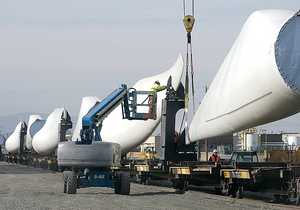forum
library
tutorial
contact

Washington's Largest Wind-Power Site
Begins Generating Electricity
by Puget Sound Energy
MarketWatch, February 29, 2012
|
the film forum library tutorial contact |

|
Washington's Largest Wind-Power Site
by Puget Sound Energy
|
Puget Sound Energy completes Lower Snake River Wind Facility, its third wind farm
 BELLEVUE, Wash., (BUSINESS WIRE) -- Washington's newest and largest wind farm -- the Lower Snake River Wind Facility-Phase I -- today began commercial operations, providing Puget Sound Energy's 1.1 million electric customers with more renewable, emissions-free power.
BELLEVUE, Wash., (BUSINESS WIRE) -- Washington's newest and largest wind farm -- the Lower Snake River Wind Facility-Phase I -- today began commercial operations, providing Puget Sound Energy's 1.1 million electric customers with more renewable, emissions-free power.
The new facility's 149 wind turbines -- set among the wind-blown farm lands of Garfield County, in southeast Washington -- will generate enough electricity, on average, to power about 100,000 homes.
"This is an important milestone for our customers and for the people of Garfield County," said Kimberly Harris, president and CEO of PSE. "With this new facility, our region is getting new jobs and a new source of clean energy."
The 343-megawatt (MW) Lower Snake River project is PSE's third wind farm. The utility's 157-MW Hopkins Ridge Wind Facility, built in 2005, is in Columbia County. The 273-MW Wild Horse Wind and Solar Facility, built in 2006 and expanded in 2009, is in Kittitas County. Together, the three sites generate enough electricity, on average, to meet the total power requirements of approximately 230,000 households.
"The Lower Snake River project has created more economic activity in Garfield County than we've seen since the early 1970s, when Lower Granite Dam was being built," said Alesia Ruchert, Garfield County managing director for the Southeast Washington Economic Development Association. "It's been a definite shot in the arm."
"I believe the project's success can be attributed to two things," she added. "One is our county's strong agricultural heritage and stewardship practices, which have laid the foundation for partnering in resource-based projects such as this. The other is the fact that PSE has demonstrated the neighborliness and pioneering spirit ingrained in our local heritage."
PSE began construction of the Lower Snake River Wind Facility in May 2010 with the help of lead contractor Renewable Energy Systems Americas Inc. (RES Americas), wind-turbine manufacturer Siemens Energy, and a variety of subcontractors. PSE also partnered with RES on the construction of the utility's Hopkins Ridge and Wild Horse wind farms.
"RES Americas was excited to be part of this large wind-energy project, which provided hundreds of jobs and major economic benefits to the Washington community. This project epitomized what wind energy can provide the country," said Jason Zingerman, vice president of Construction for RES Americas. "Our continued success with PSE is another example of our commitment to provide utilities with renewable energy development and construction expertise."
Approximately 25 permanent employees from PSE and Siemens Energy now operate the facility and maintain its wind turbines. They are based out of PSE's new operations and maintenance center in Pomeroy. About 150 workers, on average, were on site during the Lower Snake River project's two-year construction, though the number at times exceeded 250.
The Lower Snake River wind farm spans more than 21,600 acres in western Garfield County. The footprint of its wind turbines, substations, access roads and eight-mile corridor of transmission-line poles covers just 200 acres; the rest of the site remains available for farming, livestock grazing and open space. Nearly the entire site is privately owned agricultural land.
The wind facility's power output ties into the Northwest electric grid at the Bonneville Power Administration's newly completed Central Ferry substation, constructed along the wind farm's northern boundary. Lower Snake River power moves across BPA transmission lines to reach PSE's distribution system. Ninety-nine percent of PSE's electric customers reside west of the Cascades in eight Puget Sound counties (the remaining customers are in Kittitas County).
"BPA recently put in service another large substation on our transmission system to make sure the energy from this project can begin its journey to Northwest customers," said Brian Silverstein, senior vice president, BPA Transmission Services. "The substation is one of several facilities built to interconnect wind with the electric grid and will play a vital role in meeting the region's current and future energy needs."
Short videos on the new PSE energy facility can be viewed on the Lower Snake River page of PSE.com. Photos of the facility also can be viewed on PSE.com.
Key facts about the Lower Snake River Wind Facility-Phase I:Related Pages:About Puget Sound Energy
- Generating capacity of 343 megawatts; average power output will serve about 100,000 homes
- 149 wind turbines, manufactured by Siemens Energy; each turbine has a 2.3-megawatt generating capacity (enough output, on average, to serve about 700 homes)
- Each wind turbine stands 430 feet high from its base to the tip of a vertical rotor blade
- Each turbine assembly weighs 316 tons
- Turbine blades are 160 feet long; each turbine's three-blade rotor is 331 feet in diameter
- Each turbine foundation weighs more than 600 tons
- The facility's development and construction, including transmission-network upgrades for connection to the regional power grid, cost $830 million.
Washington state's oldest local energy utility, Puget Sound Energy serves more than 1.1 million electric customers and 750,000 natural gas customers in 11 counties. A subsidiary of Puget Energy, PSE meets the energy needs of its customers, in part, through cost-effective energy efficiency, procurement of sustainable energy resources, and far-sighted investment in energy-delivery infrastructure. PSE employees are dedicated to providing great customer service that is safe, dependable and efficient. For more information, visit www.PSE.com .
learn more on topics covered in the film
see the video
read the script
learn the songs
discussion forum
